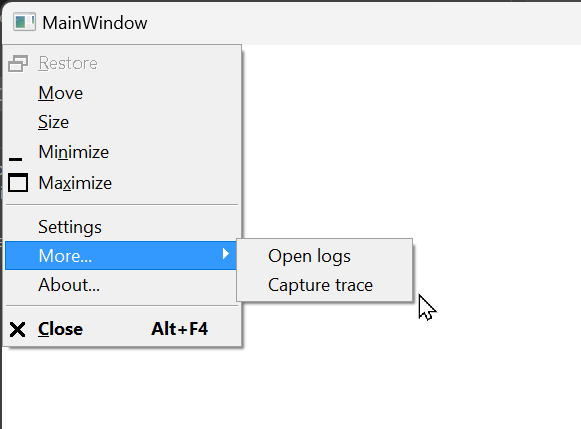#What's the system menu?
The system menu is the menu that appears when you right-click on the title bar of a window or when you press Alt+Space. It contains commands like 'Close', 'Move', 'Size', 'Minimize', 'Maximize', 'Restore', 'Help', etc. This menu is always accessible whatever the window state. Even for custom windows that don't have a title bar, you can still access the system menu by pressing Alt+Space.
It's possible to add custom menu items to the system menu. This can be useful to add advanced commands that can help you debug an issue or get access to advanced info, like 'Open logs' or 'Capture trace'.

Let's create a WinForms application and add the Microsoft.Windows.CsWin32 NuGet package. If you are not familiar with this NuGet package, you can read this post.
Shell
dotnet new winforms
dotnet add package Microsoft.Windows.CsWin32 --prerelease
We need to add the following declarations to the NativeMethods.txt file:
NativeMethods.txt
GetSystemMenu
InsertMenu
AppendMenu
CheckMenuItem
WM_SYSCOMMAND
CreatePopupMenu
The NativeMethods.txt file is used by the Microsoft.Windows.CsWin32 NuGet package to generate the Windows.Win32.PInvoke class. This class contains all the native methods that we need to extend the system menu. So, we can now add the new menu items to the system menu and handle their events:
C#
using Windows.Win32.Foundation;
using Windows.Win32.UI.WindowsAndMessaging;
public partial class Form1 : Form
{
// Values must be less than 0xF000
const nuint SettingsCommandId = 1001;
const nuint AboutCommandId = 1002;
const nuint OpenLogsCommandId = 1003;
const nuint CaptureTraceCommandId = 1004;
public Form1()
{
InitializeComponent();
// Get the system menu instance
using var menu = Windows.Win32.PInvoke.GetSystemMenu_SafeHandle(new HWND(Handle), bRevert: false);
// Insert new items
Windows.Win32.PInvoke.InsertMenu(menu, 5, MENU_ITEM_FLAGS.MF_BYPOSITION | MENU_ITEM_FLAGS.MF_SEPARATOR, 0, "");
Windows.Win32.PInvoke.InsertMenu(menu, 6, MENU_ITEM_FLAGS.MF_BYPOSITION, SettingsCommandId, "Settings");
// Create a sub-menu and add it to the system menu
using var subMenu = Windows.Win32.PInvoke.CreatePopupMenu_SafeHandle();
Windows.Win32.PInvoke.AppendMenu(subMenu, MENU_ITEM_FLAGS.MF_UNCHECKED, OpenLogsCommandId, "Open logs");
Windows.Win32.PInvoke.AppendMenu(subMenu, MENU_ITEM_FLAGS.MF_UNCHECKED, CaptureTraceCommandId, "Capture trace");
Windows.Win32.PInvoke.InsertMenu(menu, 7, MENU_ITEM_FLAGS.MF_BYPOSITION | MENU_ITEM_FLAGS.MF_POPUP, (nuint)subMenu.DangerousGetHandle(), "More...");
Windows.Win32.PInvoke.InsertMenu(menu, 8, MENU_ITEM_FLAGS.MF_BYPOSITION, AboutCommandId, "About...");
}
protected override void WndProc(ref Message m)
{
if (m.Msg == Windows.Win32.PInvoke.WM_SYSCOMMAND)
{
// Handle click events on the new menu items
switch ((nuint)m.WParam)
{
case SettingsCommandId:
MessageBox.Show("Settings was clicked");
break;
case AboutCommandId:
MessageBox.Show("About was clicked");
break;
case OpenLogsCommandId:
MessageBox.Show("Open logs was clicked");
break;
case CaptureTraceCommandId:
MessageBox.Show("Capture trace was clicked");
break;
}
}
base.WndProc(ref m);
}
}
We can now run the application and check the new menu items:
Shell
dotnet run
#WPF
Let's create a WPF application and add the Microsoft.Windows.CsWin32 NuGet package. If you are not familiar with this NuGet package, you can read this post.
dotnet new wpf
dotnet add package Microsoft.Windows.CsWin32 --prerelease
We need to add the following declarations to the NativeMethods.txt file:
NativeMethods.txt
GetSystemMenu
InsertMenu
AppendMenu
CheckMenuItem
WM_SYSCOMMAND
CreatePopupMenu
The NativeMethods.txt file is used by the Microsoft.Windows.CsWin32 NuGet package to generate the Windows.Win32.PInvoke class. This class contains all the native methods that we need to extend the system menu. So, we can now add the new menu items to the system menu and handle their events:
C#
using System;
using System.Windows;
using System.Windows.Interop;
using Windows.Win32.Foundation;
using Windows.Win32.UI.WindowsAndMessaging;
namespace WpfApp1;
public partial class MainWindow : Window
{
// Values must be less than 0xF000
const nuint SettingsCommandId = 1001;
const nuint AboutCommandId = 1002;
const nuint OpenLogsCommandId = 1003;
const nuint CaptureTraceCommandId = 1004;
public MainWindow()
{
InitializeComponent();
}
protected override void OnSourceInitialized(EventArgs e)
{
base.OnSourceInitialized(e);
// Get the HwndSource of the current window
HwndSource source = (HwndSource)PresentationSource.FromVisual(this);
// Add a hook to the message loop to manage click events
source.AddHook(WndProc);
// Add the new menu items
using var menu = Windows.Win32.PInvoke.GetSystemMenu_SafeHandle(new HWND (source.Handle), bRevert: false);
Windows.Win32.PInvoke.InsertMenu(menu, 5, MENU_ITEM_FLAGS.MF_BYPOSITION | MENU_ITEM_FLAGS.MF_SEPARATOR, 0, "");
Windows.Win32.PInvoke.InsertMenu(menu, 6, MENU_ITEM_FLAGS.MF_BYPOSITION, SettingsCommandId, "Settings");
using var subMenu = Windows.Win32.PInvoke.CreatePopupMenu_SafeHandle();
Windows.Win32.PInvoke.AppendMenu(subMenu, MENU_ITEM_FLAGS.MF_UNCHECKED, OpenLogsCommandId, "Open logs");
Windows.Win32.PInvoke.AppendMenu(subMenu, MENU_ITEM_FLAGS.MF_UNCHECKED, CaptureTraceCommandId, "Capture trace");
Windows.Win32.PInvoke.InsertMenu(menu, 7, MENU_ITEM_FLAGS.MF_BYPOSITION | MENU_ITEM_FLAGS.MF_POPUP, (nuint)subMenu.DangerousGetHandle(), "More...");
Windows.Win32.PInvoke.InsertMenu(menu, 8, MENU_ITEM_FLAGS.MF_BYPOSITION, AboutCommandId, "About...");
}
private IntPtr WndProc(IntPtr hwnd, int msg, IntPtr wParam, IntPtr lParam, ref bool handled)
{
if (msg == Windows.Win32.PInvoke.WM_SYSCOMMAND)
{
// Handle click events on the new menu items
switch ((nuint)wParam)
{
case SettingsCommandId:
MessageBox.Show("Settings was clicked");
handled = true;
break;
case AboutCommandId:
MessageBox.Show("About was clicked");
handled = true;
break;
case OpenLogsCommandId:
MessageBox.Show("Open logs was clicked");
handled = true;
break;
case CaptureTraceCommandId:
MessageBox.Show("Capture trace was clicked");
handled = true;
break;
}
}
return IntPtr.Zero;
}
}
We can now run the application and check the new menu items:
Shell
dotnet run
Do you have a question or a suggestion about this post? Contact me!